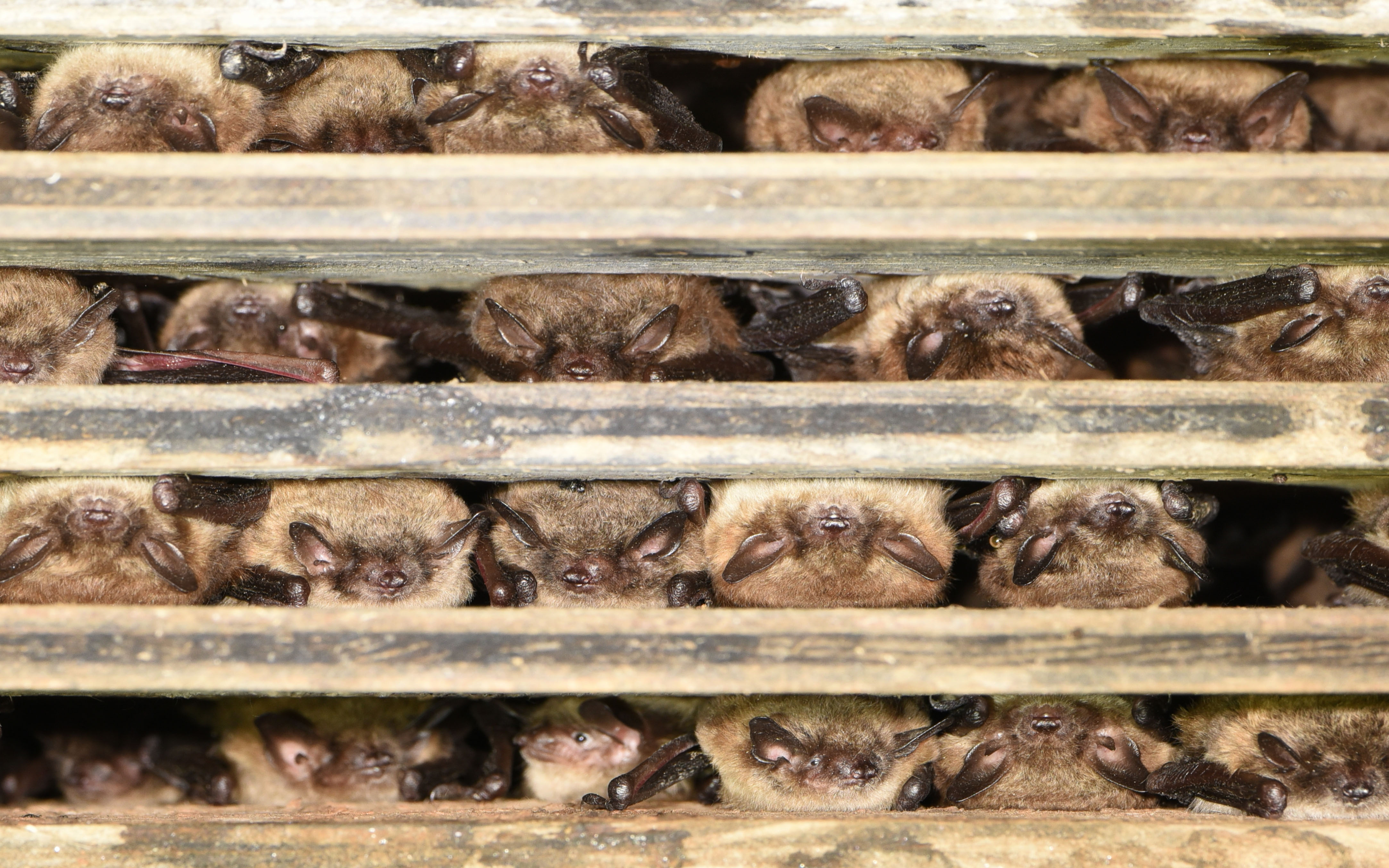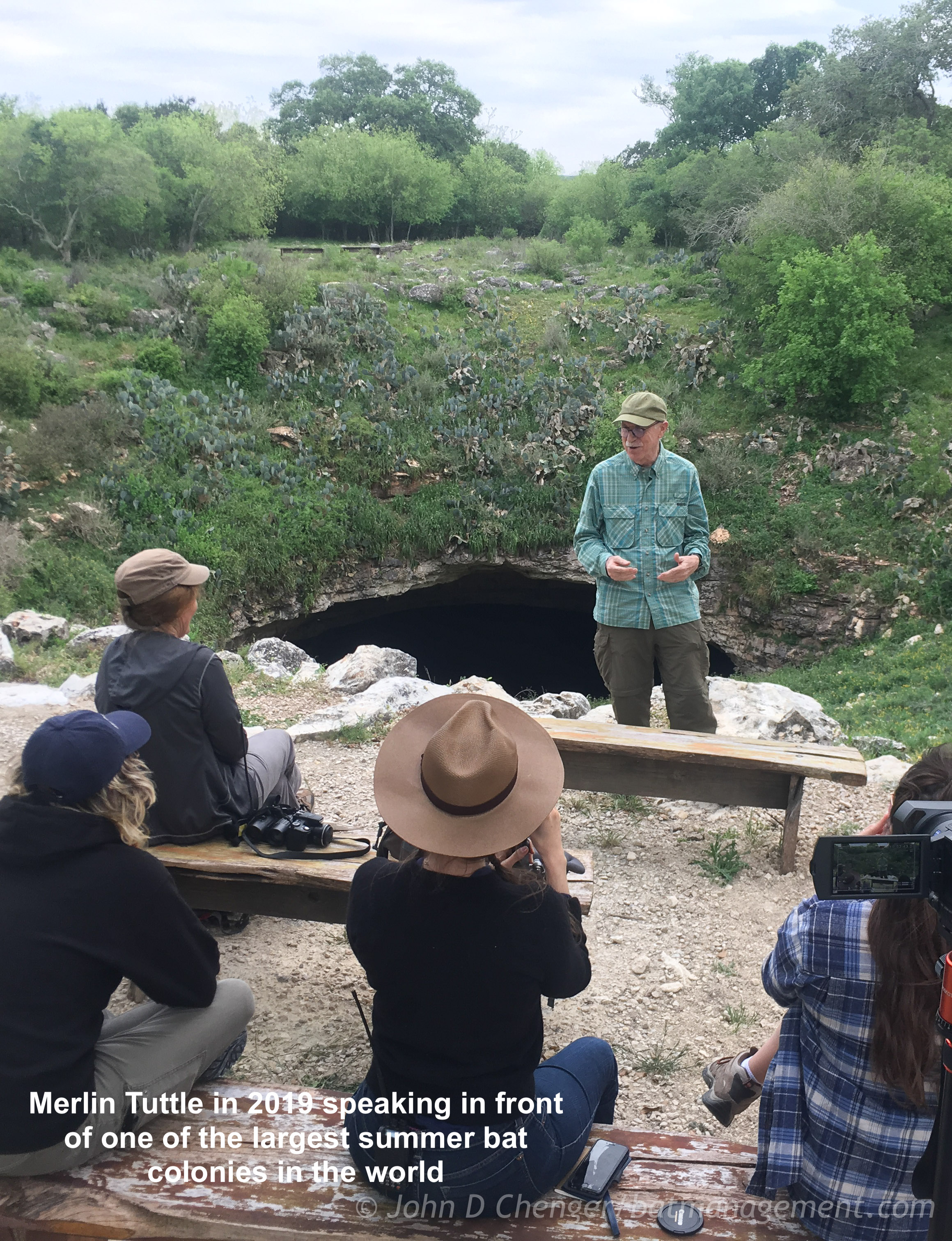
By Merlin Tuttle, Merlin Tuttle's Bat Conservation
Observations of heat-stressed, sometimes dead bats associated with bat houses, have led to unfortunate speculation that bat houses can become ecological traps that lure bats to their death. It is true that numerous bat houses are badly built and sold with unreasonable claims and little, if any, instruction on bat needs. Vendors of such houses defraud customers and threaten the credibility of bat conservation. Both vendors and customers can benefit from education and certification. Nevertheless, there is no evidence that poorly constructed bat houses threaten bat survival. Bats are smart enough to avoid bad bat houses except when desperate from lack of alternatives.
Loss of vast numbers of traditional roosts is a key cause of bat decline. Most species that occupy bat houses today originally relied on loose bark and cavities in snags that were often lost during storms. This likely explains why bats prefer to live where multiple roosting options are available.
Radio-tracking studies show that occupants of natural roosts frequently move among several, apparently to escape predators and parasites or find optimal temperatures. During severe weather, large numbers may die even in traditional roosts. With so few remaining, bats often fail to find ideal homes.
When providing bat houses, the best way to reduce mortality is to offer a variety of roosting options. Several houses ideally should be colored, positioned, or vented to provide a range of temperature. Needs vary between cool versus hot weather extremes.
Selecting a quality bat house, as well as proper placement, are crucial to success. In our forthcoming book, Danielle Cordani and I will provide plans for houses that maximally meet bat needs over a wide range of temperature. However, a single house is unlikely to prove ideal for all species and locations.
Where sufficient habitat exists, especially within easy reach of overwintering locations, available houses often become crowded, and growing numbers of young may perish for lack of available space. The same occurs at traditional roosts. We simply don’t see it. And we can’t prevent it, though careful monitoring and providing more bat house options can help.
Please consider joining Merlin Tuttle's Bat Conservation for more articles containing Merlin's timeless sage advice on bat conservation.
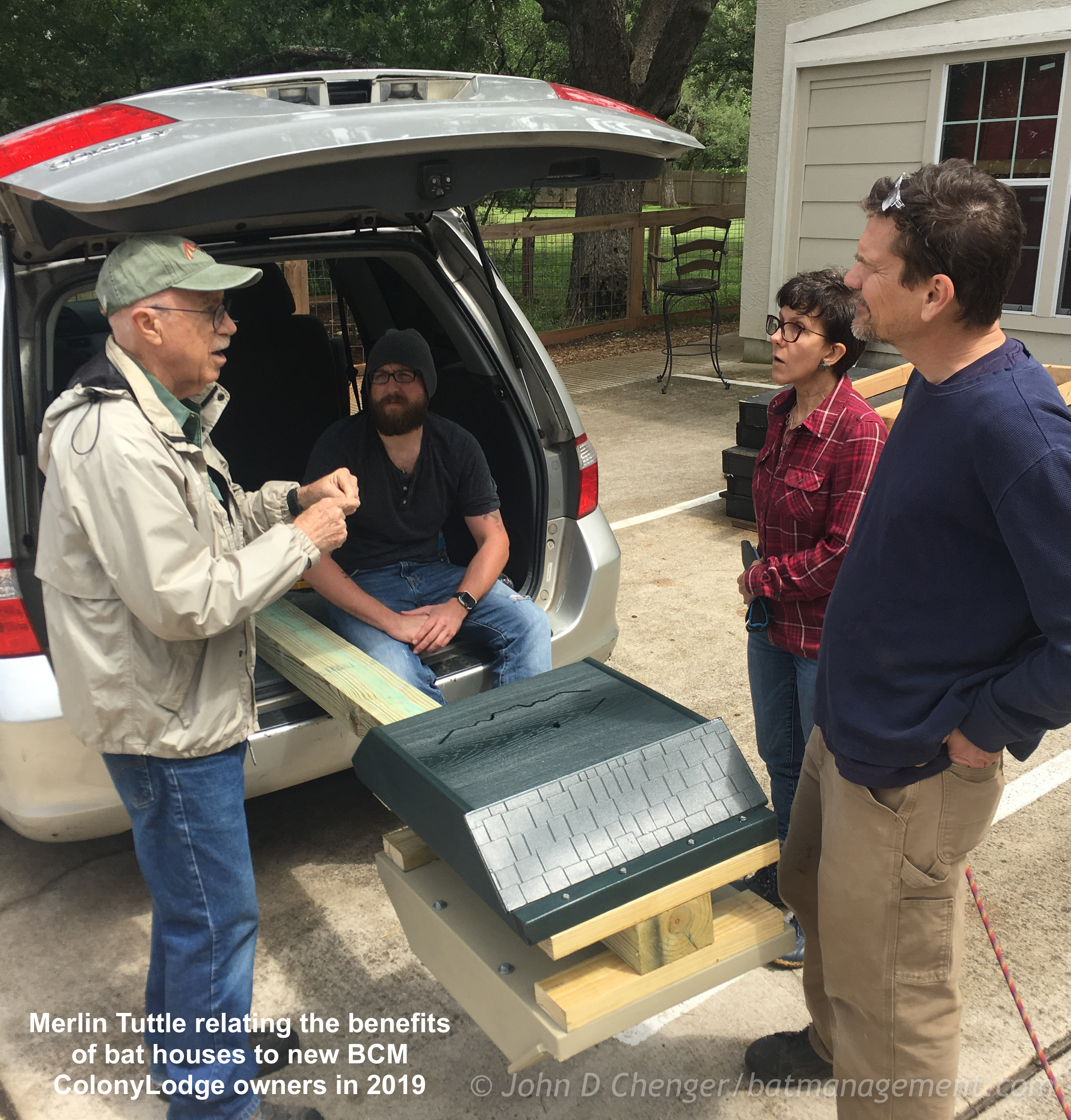
By Merlin Tuttle, Merlin Tuttle's Bat Conservation
Certainly, there are plenty of hucksters selling bad bat houses, and even good ones are too often sold with poor or bad instructions. The only remedy is to educate the public, set standards and certify vendors that meet them.
Bat houses continue to play a key role in public education at a time when exaggerated disease warnings are threatening to reverse decades of progress. We should be far more focused with educating the public and helping desperate bats than on bad or poorly instructed bat houses. It is my experience that bad, or improperly located houses are simply unused unless bats are desperate. I know of no evidence that bats abandon good, natural roosts to occupy unsuitable bat houses.
Their natural roosts beneath exfoliating bark or other cavities in snags are notoriously ephemeral, prone to blowing down during storms. Occupants often die, largely unseen, or seek shelter in artificial roosts. Even the worst built or located bat houses can become occupied to capacity where bats are sufficiently desperate, and they may eventually die as a result. But they would have perished even sooner without the artificial shelter.
When such bats die, it’s unlikely due to having been lured into a mortality sink. They might have been saved if more and better artificial roosts had been provided. The problem isn’t bad bat houses. It’s a shortage of good ones. What is needed is better bat house education.
Juvenile mortality is natural, but certainly can be exacerbated in many ways. Adverse weather, land clearing, aquatic pollution, and pesticide poisoning are known to sometimes reduce food supply for lactating mothers whose energy demands are especially high. Survival of a species sometimes demands that a food-stressed mother abandon her pup. Food is typically scarce during temperature extremes. Even in the best natural roosts, pups are occasionally abandoned by hungry mothers. Pup mortality can be caused by a variety of factors regardless of bat house use.
Over wide areas of America, we’ve repeatedly seen dramatic growth in numbers when additional bat houses were provided, suggesting roost limitation. Bat houses of almost any size or color can help bats if they are properly built and located. As a population grows, it will eventually exceed carrying capacity, whether natural or artificial. And a crowded roost will be more vulnerable to overheating. The remedy is often more shelter.
It is certainly appropriate to investigate temperature tolerance of bats as well as to improve bat house designs. It is also important to recognize that no one design, or color will meet all species needs in all locations. I would strongly caution against use of poorly collected or explained data. Good temperature data is very helpful. To be meaningful the height and width of each house tested would be needed. The existence and positioning of vents in both need to be reported, and temperature probes would need to simultaneously compare locations near ceiling, middle, and below vents. Also, units in both houses should be calibrated.
Many comparisons could be helpful. I suspect valuable information could be obtained if identical houses were compared on wooden versus brick or stone buildings. I've not seen measurements of houses mounted on stone or brick walls or chimneys versus wood, though the former are widely reported as preferred. Also, I've seen no data on the impact of wall (the mounting substrate) color on bat house temperature. I've generally advised against mounting on dark walls in warm or hot climates, fearing that rising heat would render vents useless. Finally, comparison of identical pairs of black versus white houses and houses painted black on the roof and upper third versus white below would provide potentially very useful information. Nevertheless, without clear, simultaneous comparisons with calibrated instruments, temperature data can prove more harmful than helpful. It is already well known that temperature can vary by 20°F or more from the top of a house to a horizontal vent. Too often reports omit disclosure of probe positioning or house dimensions, rendering them useless or misleading.
Please consider joining Merlin Tuttle's Bat Conservation for more articles containing Merlin's advice on bat conservation.
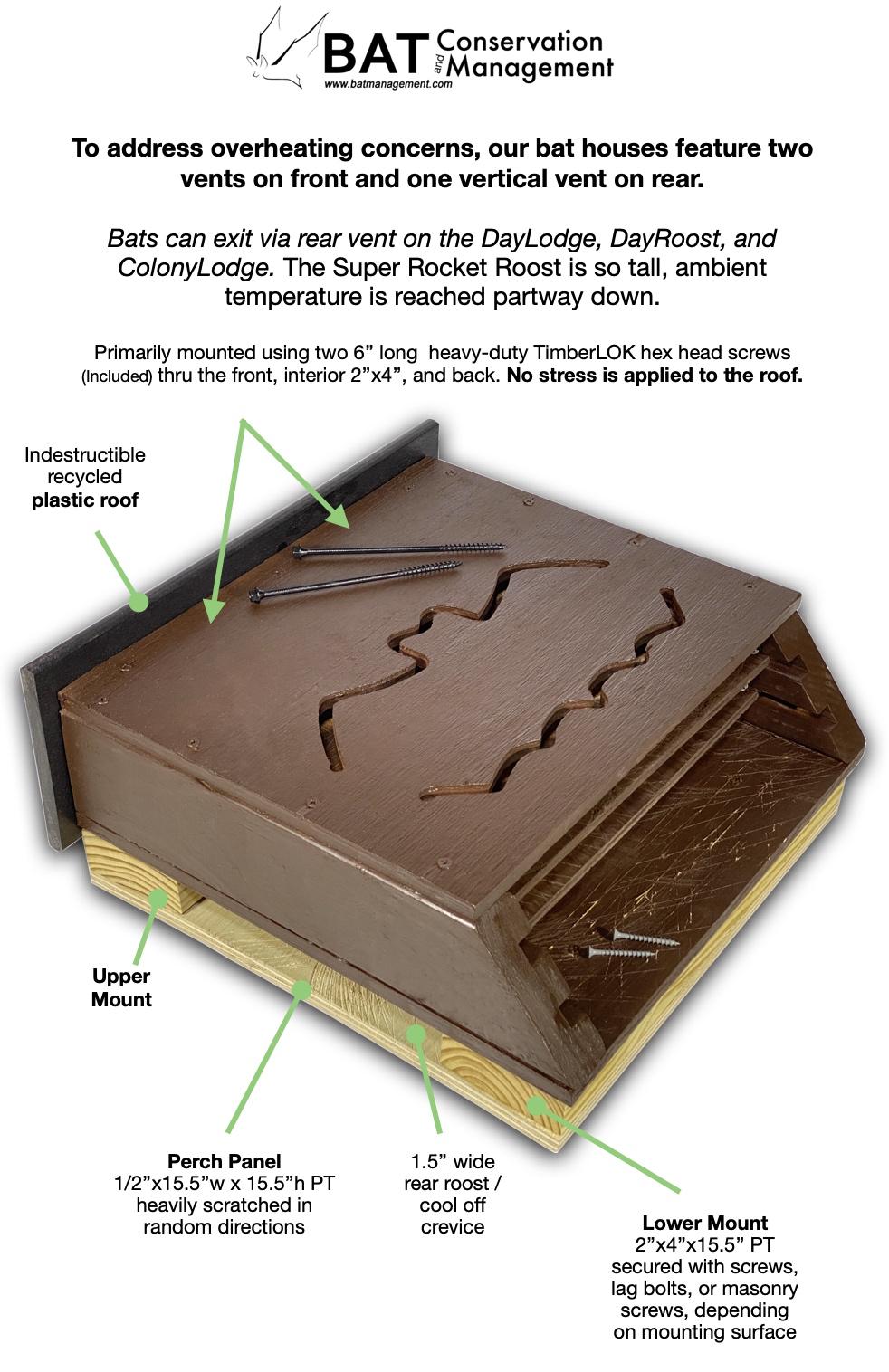
By John Chenger, Bat Conservation and Management
Most bat houses are intended to attract pregnant females as a safe haven to raise young. When setting a single new bat house, biologists tend to recommend solar exposure and color so that the roost can reach 120°F or more in the spring, when the fetus must develop rapidly and pups need to fly ASAP in the summer. We are only hoping to attract a few bats to a new house at this point, so it -needs- to be hot, or it may -never- attract bats. But after some number of bats move in, their own body heat adds to the roost. At some point outside temperature and the added body heat may become too much. All BCM bat roost structures are relatively tall, so bats can move down away from the heat pocket at the roof, and still be protected from predators. BCM bat houses have slots in the front, about 1/3rd up from the bottom to increase ventilation. Relatively unique to our designs is a rear vent that bats can exit out onto a "Perch Panel" incorporated into the mount. The Perch Panel is open on both ends for maximum ventilation but bats are still protected from predators.
There isn't a "one size fits all" bat house site and color. Once a bats really establish a roost, you will find them all snuggled inside in the early spring. As summer progresses, they may mode to -other- roosts, some may be in full shade! Later in the fall, some will consolidate in the favorite roost, others will disperse on the landscape trying out alternates. Trees fall over all the time in forests, and bats have -many- alternate places to live when one disappears. Beware of popular articles that over-generalize and quote research out of context. Bats are not dumb, and won't stay in a roost where they will bake to death. Pups, being non-volant, may be the exception.
All that said, the best advice is to put up lots of bat houses of all colors and in all types of sun conditions to give bats more options to find the conditions that best suit their needs. But if you are only installing one bat house, it really needs to be relatively warm to start attracting those first few bats.
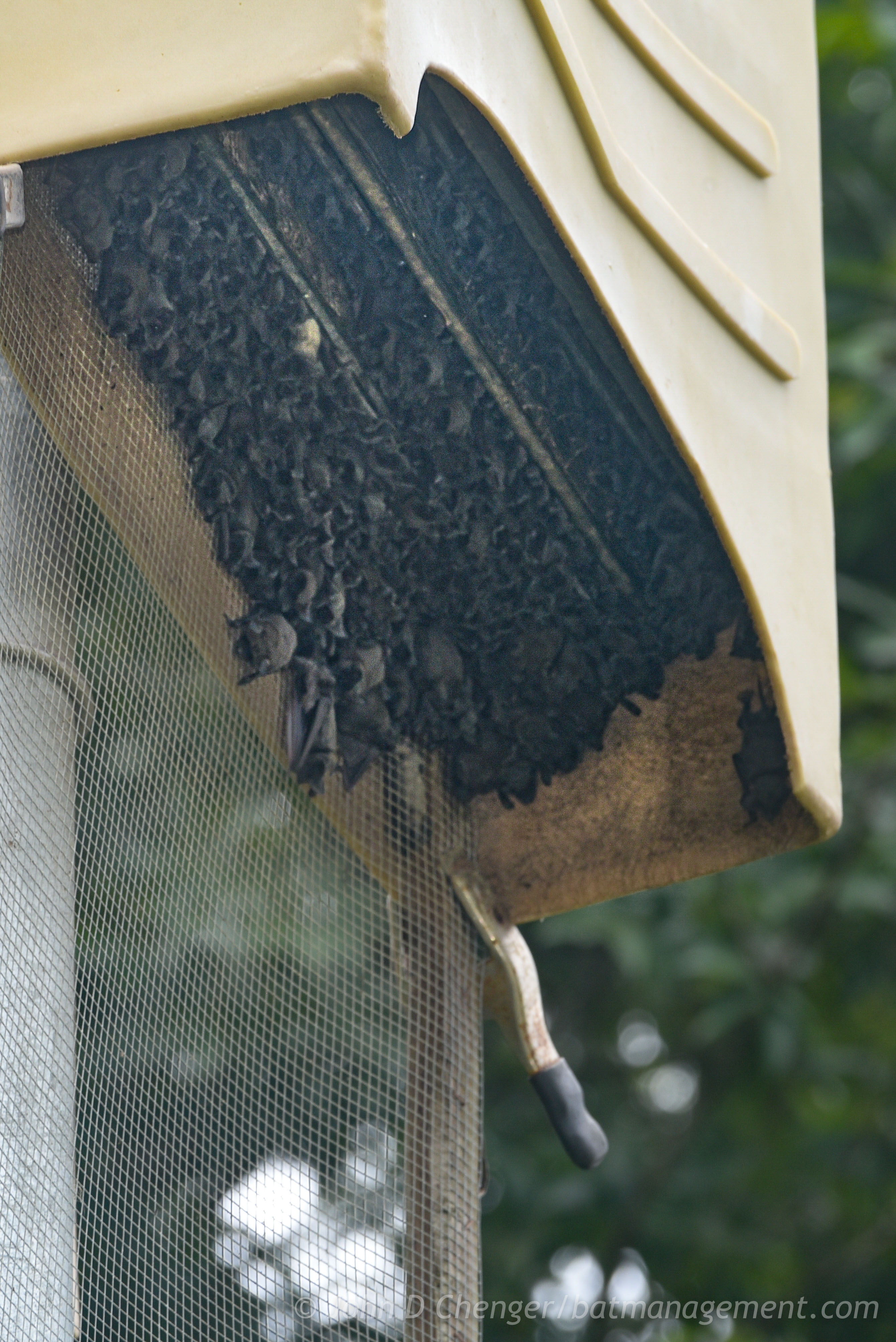
First off, if you are just starting a new bat colony and live anywhere outside the hottest desert lowlands in the US, you probably have nothing to worry about until a bunch of bats move in. Watch the behavior during the hot summer months; if your bats are constantly at the bottom of the bat house or hanging outside the bat house, they are too hot.
Add more roost space. These Mexican free-tails in Florida didn't have a problem until they filled the bat house (photo at right). Consider installing several bat houses that receive different amounts of solar exposure, ideally one that receives direct sun especially in the morning and most of the day, and another that is sunny in the morning and shaded in afternoon. Install a second bat house on the opposite side of the first.
Modify. Consider adding more vents around the bottom 1/3rd of the bat house. Use a drill to perforate the sides and front with one or two rows (or more!) of 1/2'' holes. If the back is accessible, then perforate it as well.
White or silver flashing can be added to the roof of the bat house, and even wrapped around the upper 1/3rd if desired. For more insulation from direct heat, add spacers under the metal so less heat is directly transferred to the bat house.
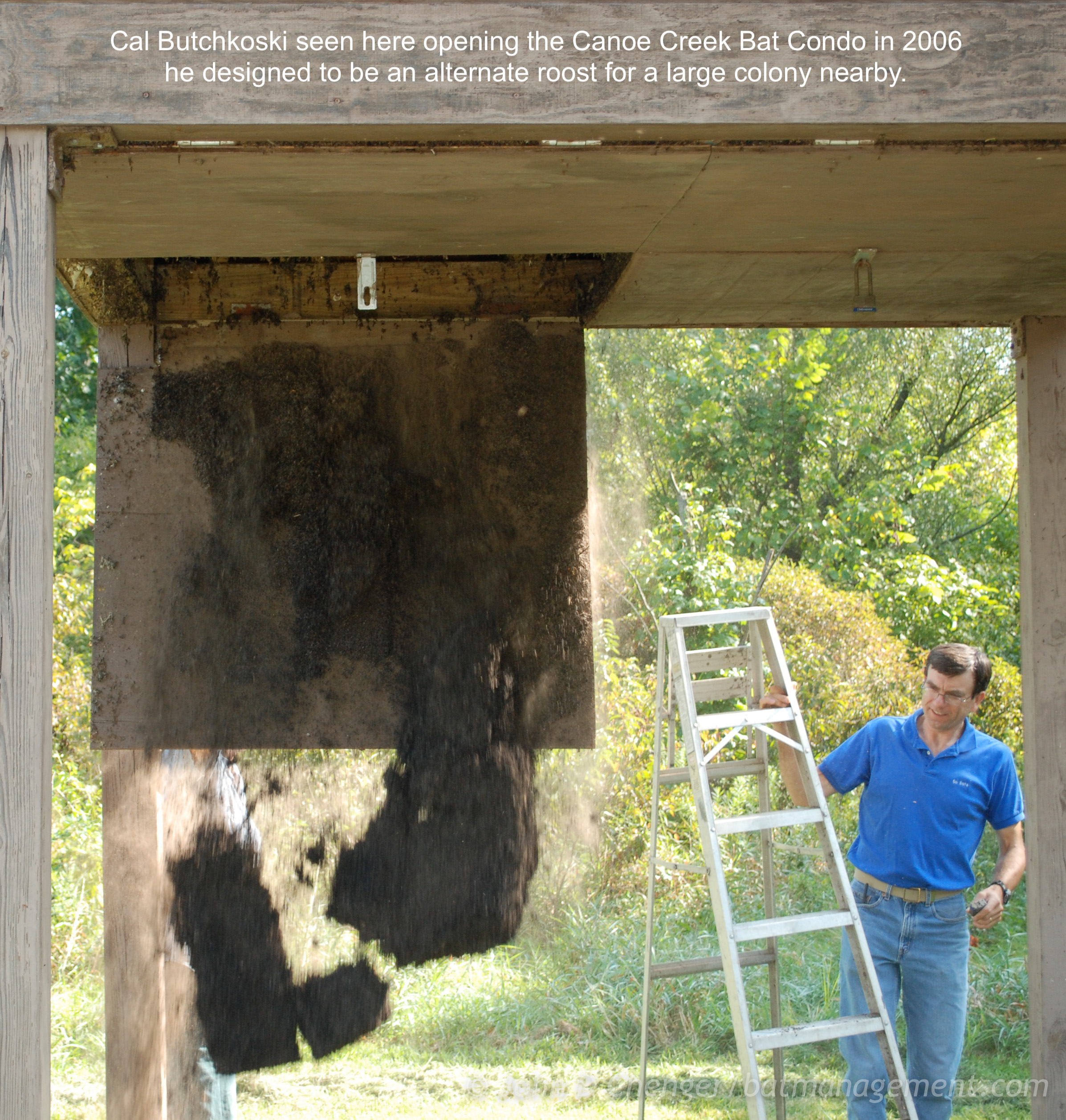
By Cal Butchkoski, Pennsylvania Game Commission Biologist (Retired)
On rare hot conditions I've had MYLU hanging below the crevices on the high portion of landing plate. These were when the boxes were reaching capacity. Good bat houses were designed for this with the bats still surrounded by the shell. Also, bats can fly into trees to cool off on really hot days. However, these are rare occasions. Also the ventilation in the boxes are designed to allow them to get to ambient temperature down low.
The metal boxes were designed to mimic temperatures within the Canoe Creek Church, a building that historically contained ~25,000 little brown bats and a small number of Indiana bats. Temperatures in both boxes & church attic reach ~140*F at the top by 1pm on hot sunny days. This was the target day & time to be in the church attic to band Indiana bats when they come out of the black metal roof crevices.
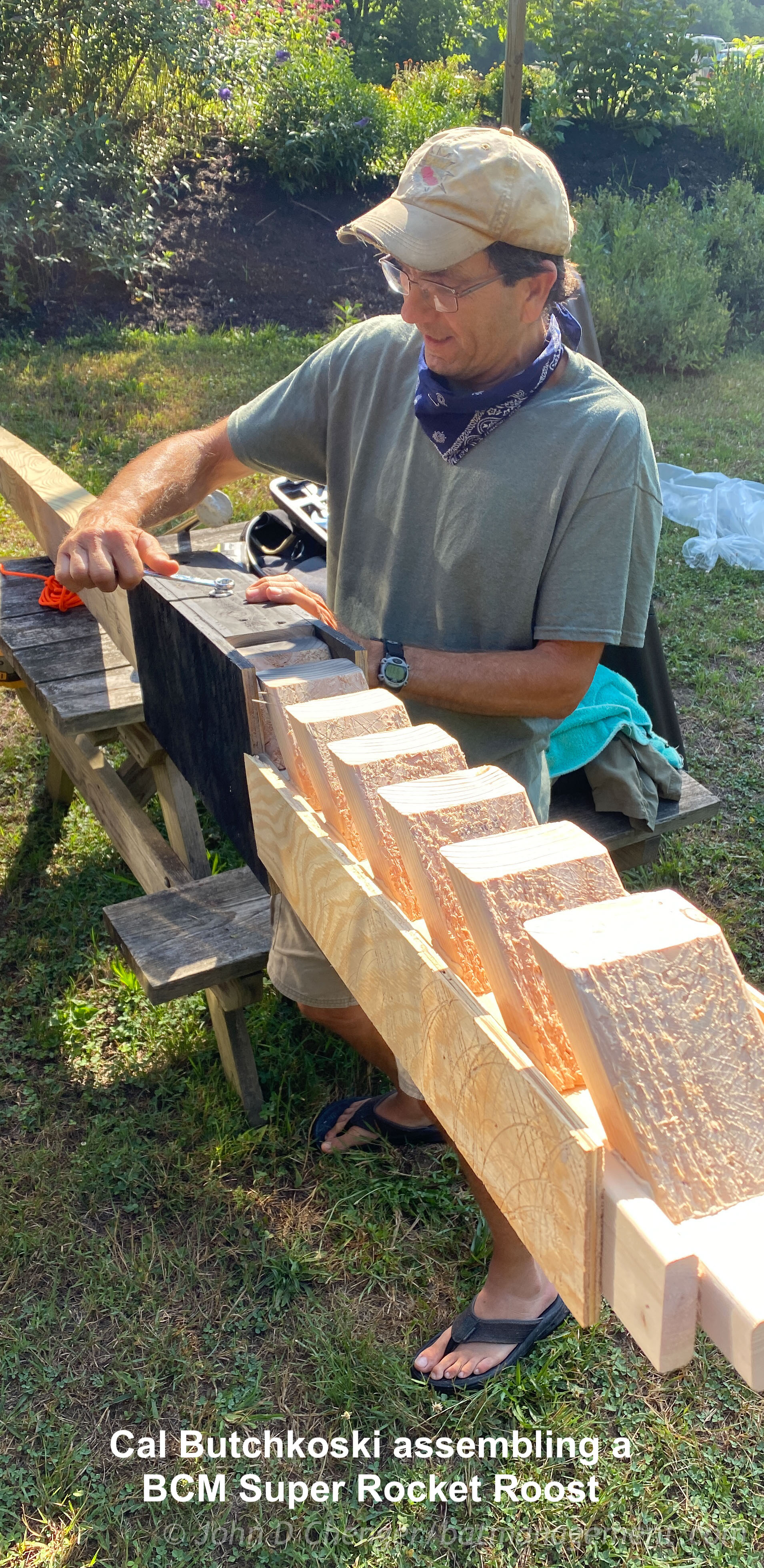
Also, any roost that gets overcrowded would get too hot on a hot sunny day... but they can move! Behavior allows them to select other alternate roosts. Alternate roost movement is well documented in literature especially with Indiana bats.
In PA and most northern or high elevation areas, you do need at least the top portion to be a dark color to help pregnant/nursing female bats save energy by minimizing heat generation during cool spring/summer (& sunny) days. They warm up quickly at sunrise.
I believe artificial roost management is a good option for poor forest mgt. That's likely why we had such great success at Canoe Creek. A managed area INCLUDES erecting more roosts when existing box capacity gets near to avoid overcrowding. And permanent management isn't that difficult. You don't need boxes everywhere. A few management areas are all that's needed. These animals can fly a few miles (& sometime many more) to foraging areas from roosts.
Anyone who does not want to get into bat mgt with artificial roosts better start managing for old growth trees with some dying with roost cavities, exfoliating bark & solar exposure. So your looking at 100+ years to get that type of habitat. Also, foresters will want to cut before that happens.
...And artificial roost management is a whole lot easier, especially with the more durable, and long lasting designs.
Gotta admit, I got tired of the maintenance involved with the all wood bat boxes, even as well designed as they were. But they are still good & less expensive way to start out and see if there is a need.
Backyard Bat Houses
Learn the differences between our base bat houses suitable for starting backyard bat colonies.
Siting and Color
Consider the options on where to locate your bat house so it's good for bats and -for you-.
Installing a Bat House
Trees, buildings, or poles?
Installing a bat house on something high can be a job, here are suggestions on how to move it along.
Maintaining a Bat House
Our bat houses are low maintainance, but there are some long term situations to be aware of.
Human Health Concerns
Bats attract more than their fair share of negative press, here are some facts to help prospective bat landlords rest easier.
Can my bat house be too hot?
Advice from real-world experts on how to recognize when is too hot, when to be concerned, and how to mitigate.

